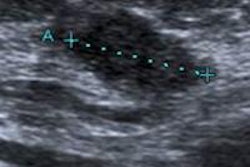ORLANDO, FL - Regardless of breast density, ultrasound outperformed MRI and digital mammography for preoperatively assessing breast tumor size, according to research presented on Tuesday at the American Institute of Ultrasound in Medicine (AIUM) meeting.
In a retrospective study, a team from the Medical University of South Carolina (MUSC) found that both ultrasound and mammography yielded better performance than MRI, which significantly overestimated tumor sizes. However, ultrasound was the highest overall performer, according to lead author Dr. Rebecca Leddy.
Accurate clinical and pathological tumor size assessment is essential for breast cancer staging and treatment planning, said Leddy, who presented the group's research during a scientific session at AIUM 2015. Preoperative cancer staging could be improved if the accuracy of various imaging modalities could be determined, she said.
Because past studies have provided different results with regards to the imaging techniques as well as inclusion/exclusion criteria, the researchers set out to reassess the accuracy of digital mammography, high-resolution ultrasound, and high-resolution MRI using more specific inclusion criteria. They also wanted to determine whether or not the accuracy of these modalities for assessing tumor size varied based on breast density or type of tumor.
In the retrospective review, the researchers evaluated 93 patients who were newly diagnosed with in situ or invasive breast cancer and seen at MUSC between January 2008 and March 2012. All of the patients had received preoperative mammography, ultrasound, and MRI; had undergone needle localization; and did not receive neoadjuvant chemotherapy. Thirty patients who had positive margins were excluded from the study, as were six patients with mammographically occult lesions.
The remaining 57 patients had a mean age of 63, and 43.9% had dense breasts. There were 48 ductal cancers (84.2%) and nine lobular carcinomas (15.8%).
Modality showdown
Board-certified breast imaging radiologists with fellowship training provided maximum tumor size on mammography, ultrasound, and MRI. The researchers documented breast density for each of the cases, and they reviewed pathology results for maximum tumor size and type of cancer. Pathology results served as the gold standard for the study.
On the digital mammograms, the maximum tumor size was measured using standard, nonmagnified craniocaudal (CC) and mediolateral-oblique (MLO) views. Standard MRI sequences were obtained using the American College of Radiology (ACR) breast MR accreditation guidelines on a dedicated phased-array breast coil. The maximum tumor size was recorded using the first postcontrast axial and sagittal T1-weighted images, or in cases of larger tumors, on a maximum intensity projection (MIP) image.
Images were acquired by radiologists or by dedicated breast imaging technologists trained in screening and diagnostic mammography and breast sonography. They used handheld techniques with a linear transducer in the 7-16 MHz frequency range. Scanning and images were obtained in the sagittal and transverse planes and three measurements of the tumor were documented in the sagittal, transverse, and anteroposterior planes. The transducer was rotated to find and record the largest tumor dimension in any plane, Leddy said.
Mean tumor measurement sizes were as follows:
- Pathology: 1.401 mm ± 0.084
- MRI: 1.768 mm ± 0.019
- Ultrasound: 1.481 mm ± 0.090
- Mammography: 1.305 mm ± 0.077
The mean tumor size with MRI was significantly larger (p < 0.001) than the pathology results; however, the differences between pathology and ultrasound and mammography were not statistically significant. MRI tumor size measurements were also significantly higher than both ultrasound and mammography (p = 0.003 and p < 0.001, respectively).
Lin's concordance correlation coefficient (CCC) analysis -- performed by the researchers to assess reproducibility -- showed that ultrasound moderately agreed with pathology (CCC = 0.71, 95% confidence interval [CI]: 0.56-0.82). Meanwhile, mammography (CCC = 0.58, 95% CI: 0.38-0.72) and MRI (CCC = 0.50, 95% CI: 0.31-0.65) had poorer levels of agreement with pathology.
No effect from density
Breast density did not affect the measurement results: There was no significant difference in measurement performance between women with dense breasts and those who had nondense breasts. A significant difference was seen, however, by type of cancer.
MRI significantly overestimated tumor size in ductal cancers (p < 0.001), while slightly underestimating tumor size in lobular cancers, according to Leddy. In addition, measurements of lobular cancers on mammography were significantly smaller than the ultrasound and MRI measurements (p < 0.05).
The higher accuracy of ultrasound when compared with MRI and mammography differed from other studies reported in the literature, according to Leddy.
"We feel this was because we obtained the maximum tumor measurement irrespective of the plane of scanning," she said.
Leddy acknowledged a number of limitations of the study, including its retrospective nature and small sample size. In addition, it did not account for mammographically occult cases, she said.




















